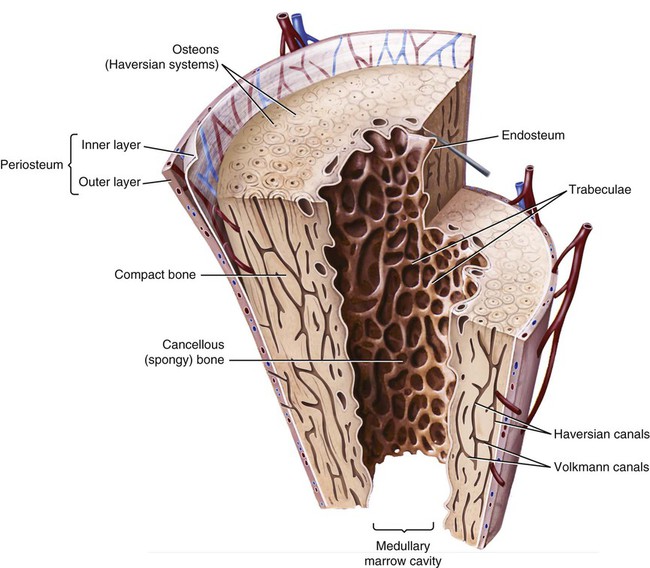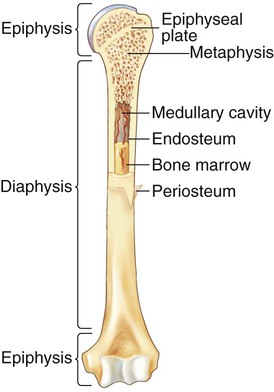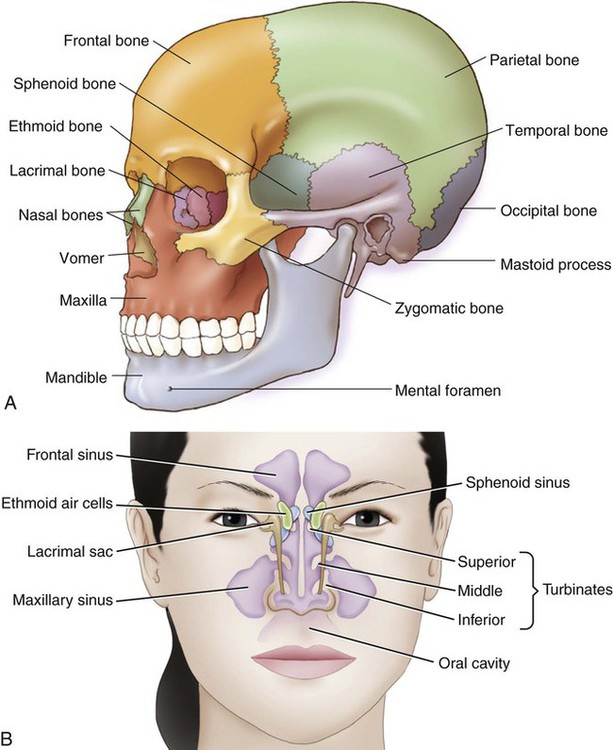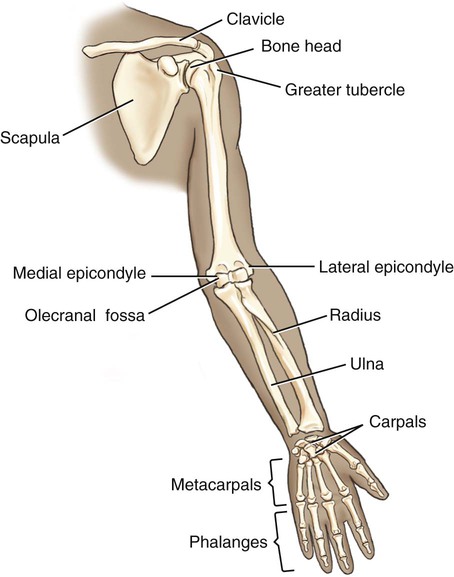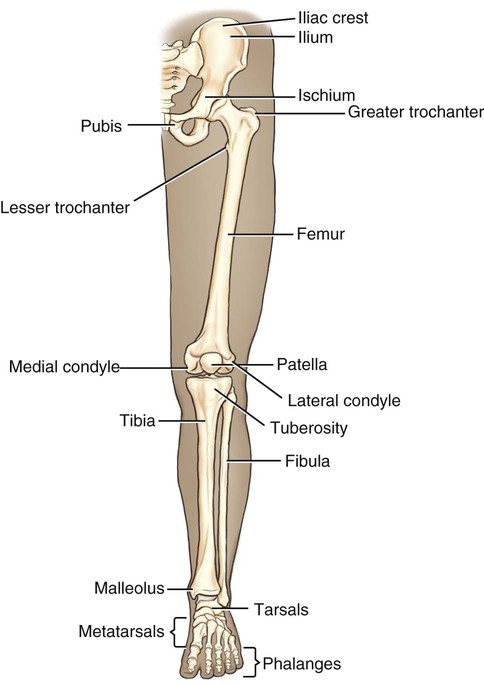Musculoskeletal System and Connective Tissue
ICD-10-CM Example from Tabular
M43.1 Spondylolisthesis
Excludes 1 acute traumatic of lumbosacral region (S33.1)
acute traumatic of sites other than lumbosacral—code to fracture, vertebra, by region
congenital spondylolisthesis (Q76.2)
M43.10. Spondylolisthesis, site unspecified
M43.11. Spondylolisthesis, occipito-atlanto-axial region
M43.12. Spondylolisthesis, cervical region
M43.13. Spondylolisthesis, cervicothoracic region
M43.14. Spondylolisthesis, thoracic region
M43.15. Spondylolisthesis, thoracolumbar region
M43.16. Spondylolisthesis, lumbar region
M43.17. Spondylolisthesis, lumbosacral region
Learning terminology of the musculoskeletal system (MS) (Fig. 3-1) is best done sequentially. Studying the names and locations of the bones and bone markings will help you recognize the names and locations of the joints and ligaments. Learning the names of the bones and muscle actions will be reinforced in the names of the muscles and tendons. Remembering the terms for surface anatomy and directional terms studied in the second chapter will help you with the terms for many of the structures in this body system.
Functions of the Musculoskeletal System and Connective Tissue
The musculoskeletal system is composed of three interrelated parts: the bones, joints (articulations), and muscles. Bones are connected to one another by fibrous bands of tissue called ligaments. Muscles are attached to the bone by bands of tissue called tendons. The tough fibrous covering of the muscles (and some nerves and blood vessels) is called the fascia.1 These structures:
Anatomy and Physiology
Skeletal System
Cartilage
• Elastic cartilage, with its stretchy elastin fibers, forms parts of the ears and nose, along with the temporary bones in the fetal skeleton. This elastic cartilage is later replaced by bone in a process termed endochondral ossification.
• Fibrocartilage, named for the bundles of collagen fibers in it, is found in the discs between the backbones (vertebrae) and pubic bones in the pelvis.
• Hyaline cartilage (also termed glassy cartilage for its appearance), that covers the ends of the long bones and serves to cushion and protect the joints, is called articular cartilage. Hyaline cartilage also forms the attachments of the ribs to the breastbone (costochondral cartilage) and parts of the voice box, windpipe, and bronchi.
The covering of the elastic and hyaline cartilage (with the exception of the articular cartilage) is called the perichondrium, which is instrumental in supplying the tissue with nutrients. Cartilage lacks a nerve supply, which means that wear and tear joint disease is not sensed until pain is registered by the bones. Also, because cartilage is avascular (meaning that it does not have a blood supply), disorders of the cartilage are often slow to heal.
Bone
As opposed to cartilage, bones (osseous tissue) are inflexible structures. There are two types of osseous tissue: cortical (also called compact) and cancellous (also called spongy or trabecular) bone (Fig. 3-2). The cortical bone is the dense, stronger, outer segment of bones, whereas cancellous bone is the more open, weaker part.
Skeleton
The skeleton itself can be divided into two parts: the axial skeleton, which is the skull, vertebrae (back bones), and rib cage, and the appendicular skeleton, which is the shoulder and pelvic girdles, and the upper and lower extremities (Fig. 3-1). The shoulder girdle connects the arms to the axial skeleton with the shoulder blades (scapulae) and collarbones (clavicles). The pelvic girdle provides attachment for the legs with its two pelvic (coxal) bones.
Bone Structure
The shaft of a long bone (Fig. 3-4) is termed the diaphysis, whereas the ends are called the epiphyses (sing. epiphysis). The end that is closer to the trunk is termed the proximal epiphysis, whereas the end that is farther away is called the distal epiphysis. The growth plate (also called the epiphyseal plate or the physis) is the site of growth for bone lengthening. This plate is “sealed” when growth stops, typically around the ages of 18-20 in most people.
Bone Markings
| Depression | Combining Form | Meaning/Function | Example |
| fissure | fissur/o | Fairly deep cleft or groove | Sphenoidal fissure |
| foramen | foramin/o | Opening or hole | Foramen magnum, mental foramina |
| fossa | foss/o | Hollow or depression, especially on the surface of the end of a bone | Olecranal fossa |
| fovea | Small pit or depression | Fovea capitis of humerus | |
| sinus/antrum | sinus/o, sin/o, antr/o | Cavity or channel lined with a membrane | Paranasal sinuses |
| sulcus | sulc/o | General term that refers to a groove or depression in an anatomical structure, not as deep as a fissure | Intertubercular sulcus of humerus |

| Process | Combining Form | Meaning/Function | Example |
| condyle | condyl/o | Rounded projection at the end of a bone that anchors the ligaments and articulates with adjacent bones | Medial condyle of the femur |
| crest | Narrow elongated elevation | Iliac crest | |
| epicondyle | epicondyl/o | Projection on the surface of the bone above the condyle | Lateral epicondyle of the humerus |
| facet | Small, smooth flat articular surface | Vertebral facets | |
| head (capitis) | Rounded, usually proximal portion of some long bones | Femoral head, humeral head | |
| neck | Narrowed area distal to a bone head | Femoral neck | |
| ramus | Branchlike extension | Mandibular ramus | |
| spine | spin/o | Thornlike projection | Spinous process of vertebra |
| trochanter | trochanter/o | One of two bony projections on the proximal ends of the femurs that serve as points of attachment for muscles | Greater trochanter |
| tubercle | tubercul/o | Nodule or small raised area | Costal tubercle |
| tuberosity | Elevation or protuberance; larger than a tubercle | Ischial tuberosity |
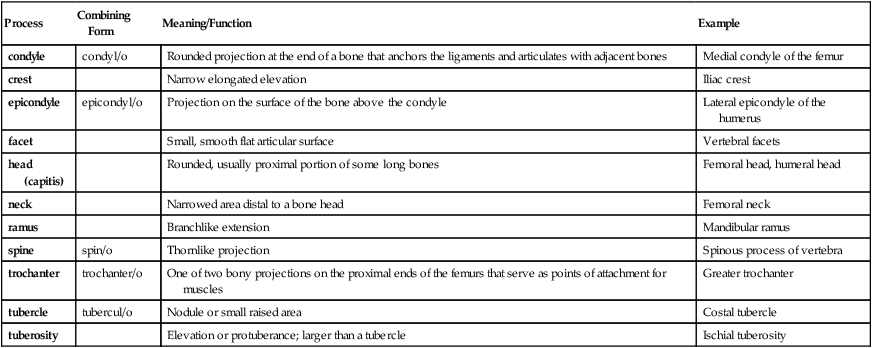
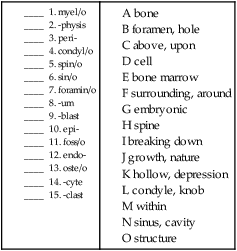
16. Osteoblasts ______________________ bone, whereas osteoclasts ______________________ bone.
17. The shaft of a long bone is called the ______________________; the ends of a long bone are called ______________________(plural!).
18. The outer covering of bone is the _______________________________________, whereas the inner lining is the ______________________.
19. A foramen, a sinus, and a fossa are examples of bone _________________________________. A condyle, a trochanter, and a tuberosity are examples of bone ______________________________________________.
20. A synonym for a sinus is a/an ___________________________________________________________________.
21. What are the five bone shapes? __________________________________________________________________.
22. The axial skeleton comprises ____________________________________________________________________.
23. The appendicular skeleton comprises _____________________________________________________________.
24. The ICD-10-PCS divides the entire skeleton into three categories. What are they? _______________________________________________________________________________________________.
25. Describe the difference between cortical and cancellous bone. ____________________________________.
Axial Skeleton
The axial skeleton includes the skull, spine, and rib cage (see Fig. 3-1).
Skull
The skull is made up of two parts: the cranium that encloses and protects the brain and the facial bones (Fig. 3-5).
Cranium
Frontal bone: Forms the anterior part of the skull and the forehead. The zygomatic process is the section of the frontal bone that extends toward the cheek.
Parietal bones: Paired bones that form the sides of the cranium.
Occipital bone: Forms the posteroinferior portion of the skull. Notable is a large hole at the ventral surface in this bone, the foramen magnum (magnum means large), which allows brain communication with the spinal cord.
Temporal bones: Paired bones that form the inferior two sides of the cranium. The mastoid process is the small, rounded protruding bone posterior to the ear. The petrous part of the temporal bone is the hard, stonelike portion of the temporal bone that protectively houses the external auditory canal and middle and inner ear. The tympanic portion is the lower area that encircles the eardrum. The zygomatic process is the anterior projection that forms the inferior portion of the cheek. The styloid process is a thin, pointed projection at the base of the temporal bone that serves as a point of attachment for ligaments and muscles.
Ethmoid bone: Single, sievelike bone forming the roof and walls of the nasal cavity. The cribriform plate (also named for its sievelike appearance) is a thin, flat structure perforated by many foramina for the olfactory nerves.
Sphenoid bone: A bat-shaped bone that forms the internal base of the skull, giving shape to the orbits of the eyes. The optic foramina are the openings that allow the optic nerve to pass through. The sella turcica is a saddle-like depression on the body of the sphenoid that holds the pituitary gland. The greater wings (also termed the alisphenoid) are the triangular projections that form the cranial wall adjacent to the petrous part of the temporal bone. The lesser wings (also called orbitosphenoids) are smaller projections that form the back of the orbit and support part of the frontal lobe of the brain.
Paranasal sinuses: Air-filled cavities that are named for the bone where they are located. Each is lined with a mucous membrane (Fig. 3-5, B). The vomer is the bone that forms the inferior/posterior part of the nasal septum.
Hyoid bone: A U-shaped bone located in the neck and attached to the styloid processes of the temporal bone.
Facial Bones
Use Fig. 3-5 to locate the names and locations of the majority of the following facial bones:
Zygoma: Cheekbone. Also called the malar or zygomatic bone.
Lacrimal bones: Paired bones at the corner of each eye that cradle the tear ducts.
Orbit: The bony socket of the eyeball. It is composed of the ethmoid, frontal, lacrimal, maxilla, palatine, sphenoid, and zygomatic bones.
Maxilla: Upper jaw bone. Also called the maxillary bone. The maxillary alveolar processes are the cavities that hold the teeth in.
Mandible: Lower jaw bone. Also called the mandibular bone. The mental foramina are the holes in the central part (body) of the mandible. The rami are posterior vertical projections. The condyloid process is a posterior projection of the ramus that articulates with the temporal bone. The coronoid process is the anterior projection of the ramus. The mandibular notch is the depression between the coronoid and condylar processes.
Palatine bones: Structures that make up part of the roof of the mouth.
Nasal bones: Pair of small bones that make up the bridge of the nose. The vomer is the bone that forms the posterior/inferior part of the nasal septum between the nostrils. The nasal septum is the wall that separates the nostrils.
Rib Cage
The ribs (costa) consist of 12 pairs of thin, flat bones attached to the thoracic vertebrae in the back and to costochondral tissue in the front (Fig. 3-6). The head and neck of the ribs are closest to the vertebrae. The ribs can be categorized as follows:
• True ribs: Seven pairs attached directly to the breastbone (sternum) in the front of the body
• False ribs: Five pairs attached to the sternum by cartilage
• Floating ribs: Two pairs of false ribs not attached in the front of the body at all
In addition to ribs, the rib cage includes the sternum, also known as the breastbone. The sharp point at the most inferior aspect of the sternum is called the xiphoid process. The combing form xiph/o is derived from the Greek word for sword, which the xiphoid resembles.
Spine
The spinal or vertebral column is divided into five regions from the neck to the tailbone. It is composed of 26 bones called the vertebrae (Fig. 3-6). The following table lists the bones in the spine.
| Region | Type and Abbreviation |
| cervical | neck bones (C1-C7) |
| thoracic | upper back (T1-T12) |
| lumbar | lower back (L1-L5) |
| sacral | sacrum (S1-S5) (5 bones fused as one) |
| coccygeal (tailbone) | coccyx or tailbone |
C1 is called the atlas for the Greek god who held up the world. C2 is called the axis for its role in permitting rotation of the head. Unique to C2 is the dens (also termed the odontoid process), which is a small, toothlike projection for the first cervical vertebra to rotate around.

Decode the following terms below using your knowledge of word parts.
17. submandibular _________________________________________________________________________________
18. costochondral __________________________________________________________________________________
19. lumbosacral ____________________________________________________________________________________
20. thoracic ________________________________________________________________________________________
21. substernal ______________________________________________________________________________________
Appendicular Skeleton
The appendicular skeleton is divided into the upper appendicular and lower appendicular skeletons.
Upper Appendicular Skeleton
The upper appendicular skeleton (Fig. 3-7) includes the shoulder girdle (scapula, clavicle, upper humerus) and the arm bones. Refer to Fig. 3-8A for a closer look at the shoulder.

Scapula: The scapulae, or shoulder blades, are flat bones that help to support the arms. The acromion process is the lateral protrusion of the scapula that forms the highest point of the shoulder. The glenoid cavity (the arm socket) is the depression in the scapula that is the seat of the head of the humerus (syn. glenoid fossa). The coracoid process is the beaklike process of the scapula that serves as a point of attachment for muscles and ligaments in the shoulder.
Clavicle: The clavicle, or collarbone, is one of a pair of long, curved horizontal bones that attach to the upper sternum at one end and the acromion process of the scapula at the other. These bones help to stabilize the shoulder anteriorly. A “wishbone” is composed of the fused clavicles of a bird.
Humerus: Upper arm bone. The bone head (caput) is the proximal enlarged round end that articulates with the glenoid cavity. The anatomical neck is immediately below the humeral head, whereas the surgical neck is below the tuberosities distal to the anatomical neck. The greater tubercle is the larger of two protuberances, whereas the adjacent lesser tubercle is obviously the other. Both function as points of attachment for muscles. The long narrow part of the humerus shaft is capped by the medial and lateral epicondyles at the distal end.
Radius: Lower lateral arm bone parallel to the ulna. The distal end articulates with the thumb side of the hand. The ulnar notch is the small cavity that articulates with the ulna at the distal end of the radius. It is also called the sigmoid cavity.
Ulna: Lower medial arm bone. The distal end articulates with the little finger side of the hand. The radial notch is the cavity that articulates with the radius at its proximal end. The radial notch is also termed the lesser sigmoid cavity. The olecranon is a proximal projection of the ulna that forms the tip of the elbow. Commonly known as the funny bone, this structure is actually a process.
Carpus: The eight bones of the carpus (wrist) are each named for a shape: the capitate (head), hamate (hooked), lunate (moon), pisiform (pea), scaphoid (boat), trapezium (table), trapezoid (table), and triquetrum (three corner) (see Fig. 3-8, B for radiograph of the carpus and metacarpus bones).
Metacarpus: One of the five bones that form the middle part of the hand.
Phalanx: One of the 14 bones that constitute the fingers of the hand, two in the thumb and three in each of the other four fingers (pl. phalanges). The three bones in each of the four fingers are differentiated as proximal, medial, and distal. The joints between these are referred to as proximal and distal interphalangeal (PIP, DIP) joints. When one is referring to a whole finger (or toe), the term digitus is used. The thumb is called the pollex.
Lower Appendicular Skeleton
The lower half of the appendicular skeleton can be divided into the pelvic girdle (the bony pelvis, sacrum, and coccyx) and the leg bones (Fig. 3-9). The pelvis is composed of two coxal (hip) bones that are connected in the front at the pubic symphysis and in the back at the sacrum. Each coxa is composed of three fused bones that together form the hip socket, the acetabulum, for the head of the thighbone. The three fused bones are the:
Ilium: The superior and widest bone of the pelvis. The iliac crest is the upper edge of the bone.
Ischium: The lower, posterior portion of the pelvic bone.
Pubis or pubic bone: The lower anterior part of the pelvic bone. The obturator foramina are the two openings between the ischium and pubis on both sides of the pelvic bone. The term obturate means to “stop up” or “block,” and was used to name this opening because on dissection it was found to be filled with muscles and nerves.
The leg is composed of the:
Femur: Thigh bone, upper leg bone. The femoral head articulates with the hipbone at the acetabulum. The femoral neck connects the head to the shaft where two protuberances, the greater and lesser trochanters, serve as sites of muscle attachment. At the distal end of the shaft are medial and lateral condyles that articulate with the condyles of the tibia. Slightly above those are the medial and lateral epicondyles.
Patella: Kneecap, a sesamoid bone that is encased in the quadriceps femoris tendon and helps to protect the knee joint.
Tibia: Shinbone, lower medial leg bone. The proximal end of the tibia has both medial and lateral condyles, whereas the distal end has a medial malleolus, a process that extends inward.
Fibula: Smaller, lower lateral leg bone. The head of the fibula is at its proximal end, where it articulates with the lateral condyle of the tibia. The body (shaft) of the fibula has a diamond-like appearance, with each of the four surfaces named for the direction it faces: anteromedial, anterolateral, posteromedial and posterolateral. The lateral malleolus is the process that extends outward at the distal end of the bone.
Tarsus: One of the seven bones of the ankle including the calcaneus (heel bone), cuboid (box-shaped), cuneiforms (medial, lateral, and intermediate wedge-shaped bones), navicular (boat-shaped), and talus (the second largest tarsal bone). The talus is named from the Latin for its shape like a die (singular of dice), as it was used as a game piece in ancient times.





